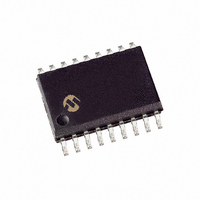PIC16F627-04/SO Microchip Technology, PIC16F627-04/SO Datasheet - Page 76

PIC16F627-04/SO
Manufacturer Part Number
PIC16F627-04/SO
Description
IC MCU FLASH 1KX14 COMP 18SOIC
Manufacturer
Microchip Technology
Series
PIC® 16Fr
Datasheet
1.PIC16F627-04P.pdf
(170 pages)
Specifications of PIC16F627-04/SO
Core Size
8-Bit
Program Memory Size
1.75KB (1K x 14)
Core Processor
PIC
Speed
4MHz
Connectivity
UART/USART
Peripherals
Brown-out Detect/Reset, POR, PWM, WDT
Number Of I /o
16
Program Memory Type
FLASH
Eeprom Size
128 x 8
Ram Size
224 x 8
Voltage - Supply (vcc/vdd)
3 V ~ 5.5 V
Oscillator Type
Internal
Operating Temperature
0°C ~ 70°C
Package / Case
18-SOIC (7.5mm Width)
Controller Family/series
PIC16F
No. Of I/o's
16
Eeprom Memory Size
128Byte
Ram Memory Size
224Byte
Cpu Speed
4MHz
No. Of Timers
3
Processor Series
PIC16F
Core
PIC
Data Bus Width
8 bit
Data Ram Size
224 B
Interface Type
SCI, USART
Maximum Clock Frequency
4 MHz
Number Of Programmable I/os
16
Number Of Timers
3
Operating Supply Voltage
3 V to 5.5 V
Maximum Operating Temperature
+ 70 C
Mounting Style
SMD/SMT
3rd Party Development Tools
52715-96, 52716-328, 52717-734
Development Tools By Supplier
PG164130, DV164035, DV244005, DV164005, PG164120, ICE2000, DM163014, DM164120-4
Minimum Operating Temperature
0 C
Lead Free Status / RoHS Status
Lead free / RoHS Compliant
For Use With
XLT18SO-1 - SOCKET TRANSITION 18SOIC 300MILAC164010 - MODULE SKT PROMATEII DIP/SOIC
Data Converters
-
Lead Free Status / Rohs Status
Details
Available stocks
Company
Part Number
Manufacturer
Quantity
Price
Company:
Part Number:
PIC16F627-04/SO
Manufacturer:
MIC
Quantity:
933
Part Number:
PIC16F627-04/SO
Manufacturer:
MICROCHI
Quantity:
20 000
PIC16F62X
FIGURE 12-4:
12.2
In this mode, the USART uses standard non-return to
zero (NRZ) format (one START bit, eight or nine data
bits and one STOP bit). The most common data format
is 8 bits. A dedicated 8-bit baud rate generator is used
to derive baud rate frequencies from the oscillator. The
USART transmits and receives the LSb first. The
USART’s transmitter and receiver are functionally
independent but use the same data format and baud
rate. The baud rate generator produces a clock either
x16 or x64 of the bit shift rate, depending on bit BRGH
(TXSTA<2>). Parity is not supported by the hardware,
but can be implemented in software (and stored as the
ninth data bit). Asynchronous mode is stopped during
SLEEP.
Asynchronous mode is selected by clearing bit SYNC
(TXSTA<4>).
The USART Asynchronous module consists of the
following important elements:
• Baud Rate Generator
• Sampling Circuit
• Asynchronous Transmitter
• Asynchronous Receiver
12.2.1
The USART transmitter block diagram is shown in
Figure 12-5. The heart of the transmitter is the transmit
(serial) shift register (TSR). The shift register obtains its
data from the read/write transmit buffer, TXREG. The
TXREG register is loaded with data in software. The
TSR register is not loaded until the STOP bit has been
transmitted from the previous load. As soon as the
STOP bit is transmitted, the TSR is loaded with new
data from the TXREG register (if available). Once the
TXREG register transfers the data to the TSR register
(occurs in one T
flag bit TXIF (PIR1<4>) is set. This interrupt can be
enabled/disabled by setting/clearing enable bit TXIE
( PIE1<4>). Flag bit TXIF will be set regardless of the
state of enable bit TXIE and cannot be cleared in
DS40300C-page 74
(RB1/RX/DT pin)
USART Asynchronous Mode
Baud CLK
USART ASYNCHRONOUS
TRANSMITTER
x16 CLK
CY
RX
), the TXREG register is empty and
RX PIN SAMPLING SCHEME, BRGH = 0 OR BRGH = 1
1
2
3
4
5
6
Preliminary
7
Samples
8
software. It will RESET only when new data is loaded
into the TXREG register. While flag bit TXIF indicated
the status of the TXREG register, another bit TRMT
(TXSTA<1>) shows the status of the TSR register.
STATUS bit TRMT is a read only bit which is set when
the TSR register is empty. No interrupt logic is tied to
this bit, so the user has to poll this bit in order to
determine if the TSR register is empty.
Transmission is enabled by setting enable bit TXEN
(TXSTA<5>). The actual transmission will not occur
until the TXREG register has been loaded with data
and the baud rate generator (BRG) has produced a
shift clock (Figure 12-5). The transmission can also be
started by first loading the TXREG register and then
setting enable bit TXEN. Normally when transmission
is first started, the TSR register is empty, so a transfer
to the TXREG register will result in an immediate
transfer to TSR resulting in an empty TXREG. A back-
to-back transfer is thus possible (Figure 12-7). Clearing
enable bit TXEN during a transmission will cause the
transmission to be aborted and will RESET the
transmitter. As a result the RB2/TX/CK pin will revert to
hi-impedance.
In order to select 9-bit transmission, transmit bit TX9
(TXSTA<6>) should be set and the ninth bit should be
written to TX9D (TXSTA<0>). The ninth bit must be
written before writing the 8-bit data to the TXREG
register. This is because a data write to the TXREG
register can result in an immediate transfer of the data
to the TSR register (if the TSR is empty). In such a
case, an incorrect ninth data bit may be loaded in the
TSR register.
9
START bit
Note 1: The TSR register is not mapped in data
10
11
2: Flag bit TXIF is set when enable bit TXEN
Baud CLK for all but START bit
memory so it is not available to the user.
is set.
12
13
14
2003 Microchip Technology Inc.
15
16
1
2
Bit0
3














